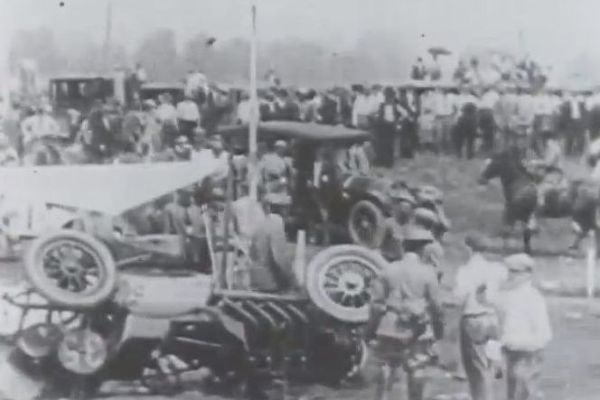



On May 30, 1911, Ray Harroun drives his single-seater Marmon Wasp to victory in the inaugural Indianapolis 500, now one of the world’s most famous motor racing competitions.
The Indiana automobile dealer Carl Fisher first proposed building a private auto testing facility in 1906, in order to address car manufacturers’ inability to test potential top speeds of new cars due to the poorly developed state of the public roadways. The result was the Indianapolis Motor Speedway, built on 328 acres of farmland five miles northwest of downtown Indianapolis. The idea was that occasional races at the track would pit cars from different manufacturers against each other in order to showcase their full power and entice spectators to check out the new models themselves. In 1911, Fisher and his partners decided to focus on one long race per year, as opposed to numerous shorter events, in order to attract more publicity. The purse for the grueling 500-mile race would be the richest in racing.
On May 30, 1911, 40 cars lined up at the starting line for the first Indy 500. A multi-car accident occurred 13 laps into the race, and the ensuing chaos temporarily disrupted scoring, throwing the finish into dispute when the eventual runner-up, Ralph Mulford, argued that he was the rightful winner. It was Ray Harroun, however, who took home the $14,250 purse, clocking an average speed of 74.59 mph and a total time of 6 hours and 42 minutes. The Wasp was the first car with a rear-view mirror, which Harroun had installed in order to compensate for not having a mechanic in the seat next to him to warn of other cars passing.
Impressive as it was, Harroun’s 1911 speed would have finished him 10th in the 1922 Indy 500. Barely a decade later, nearly all the cars that started in the race were smaller, lighter, more efficient and far more expensive than consumer cars. Their aerodynamic bodies featured narrow grills and teardrop-shaped tails; knock-off wire wheels made for quick, efficient tire changes; and the new straight-sided tires lasted much longer than their early pneumatic counterparts. The best cars were equipped with four-wheel hydraulic brakes and inline 3.0-liter V-8 engines made of aluminum. By the mid-1920s, the Indy 500 had become what it is today–a high-paying event for the world’s most expensive cars.
It is my sincere desire to provide readers of this site with the best unbiased information available, and a forum where it can be discussed openly, as our Founders intended. But it is not easy nor inexpensive to do so, especially when those who wish to prevent us from making the truth known, attack us without mercy on all fronts on a daily basis. So each time you visit the site, I would ask that you consider the value that you receive and have received from The Burning Platform and the community of which you are a vital part. I can't do it all alone, and I need your help and support to keep it alive. Please consider contributing an amount commensurate to the value that you receive from this site and community, or even by becoming a sustaining supporter through periodic contributions. [Burning Platform LLC - PO Box 1520 Kulpsville, PA 19443] or Paypal
-----------------------------------------------------
To donate via Stripe, click here.
-----------------------------------------------------
Use promo code ILMF2, and save up to 66% on all MyPillow purchases. (The Burning Platform benefits when you use this promo code.)





Inline v8?
yeah–whut?
Body by Fisher